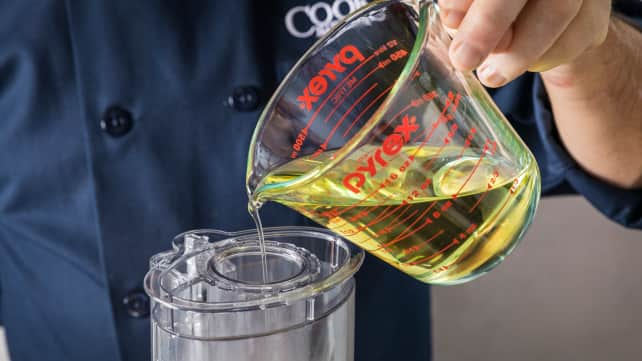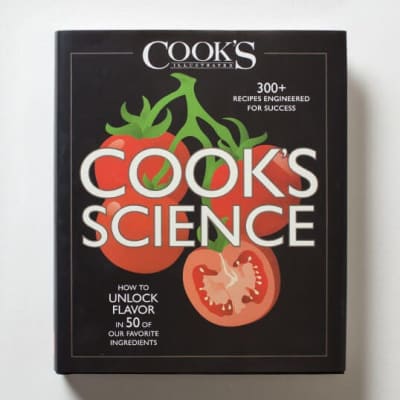If you’ve eaten homemade mayonnaise, you know that its custardy richness and delicate tang are clean and clear in a way the commercial stuff just isn’t.
Homemade Mayo with Pasteurized Yolks
Published Feb. 28, 2023.

It lights up anything it touches—from egg or potato salad to lobster rolls, boiled artichokes, and green goddess dressing—and is the only condiment worth slathering onto a BLT or high-summer tomato sandwich.
There are practical perks too: Making a batch takes minutes, most of the work can be done in a food processor, and there’s a good chance you have all the ingredients on hand.
If you haven’t made mayonnaise, I’m guessing it’s for one of two reasons. First, homemade mayonnaise is prone to breaking into a runny, greasy mess instead of forming a thick, creamy spread. Second, unlike commercial mayonnaise that’s made with pasteurized eggs, homemade versions are typically prepared with unpasteurized raw eggs, which limits their food safety and means they don't last long in the fridge.
But what if there was a truly reliable recipe for homemade mayonnaise—and it used eggs cooked just enough to pasteurize them? For the sake of BLTs everywhere, I had to try.
Sign up for the Cook's Insider newsletter
The latest recipes, tips, and tricks, plus behind-the-scenes stories from the Cook's Illustrated team.
Mayo: An Oil-In-Water Emulsion
To understand how mayonnaise works (or why it doesn’t), you first have to understand emulsions—combinations of two liquids that don’t ordinarily mix, such as oil and water. The only way to combine them is to whisk or process them so vigorously that one of the two ingredients breaks into tiny droplets that are suspended in, and separated by, the other. In mayonnaise, it’s the oil that gets broken up. Eventually, the droplets are small enough that they remain separated by the water and the two fluids effectively become one.
A third ingredient, called an emulsifier, helps stabilize the mixture.
Without an emulsifier in the mix, many of the tiny oil droplets start to find each other and coalesce, eventually “breaking” the mixture back into two separate fluids. And that’s where the egg yolks come in: They contain a powerful emulsifier called lecithin that stabilizes the emulsion by surrounding the oil droplets, preventing them from finding one another and merging into greasy pools.
But raw eggs can pose a health risk. More on that later.
Mayo Under the Microscope

If you were to zoom in on a dense emulsion such as mayo, you would see tons of tiny oil droplets tightly packed together—but not actually touching. Keeping those droplets separate is the key to a stable emulsion. But it’s a fragile business because the droplets are attracted to one another, and if they merge, the emulsion fails. That’s why emulsions contain emulsifiers (in mayonnaise, these are the lecithin in egg yolks and the polysaccharides in mustard), which form thin barriers around each oil droplet so that they can coexist without coalescing into greasy pools.
Establishing a Fully Emulsified Base
Most mayonnaise recipes that are made in the food processor call for placing all the ingredients except the oil in the processor bowl and then very slowly drizzling in the oil while the machine is running. It’s essential that the first few tablespoons of oil be added gradually, because doing so establishes a “base emulsion” with plenty of oil droplets that are well coated with lecithin. Once formed, this base helps emulsify the remaining oil.
But often, as soon as the motor starts running, the yolks and the lemon juice or vinegar get sprayed up the sides of the bowl. So when you first add the oil, there is not enough liquid volume in the bowl to engage the processor blade, and the oil merely collects below the blade in a greasy pool.
As you keep drizzling in the oil, there will eventually be enough liquid to engage the blade, but since so much of the water from the yolks and acid is lost to the sides of the processor bowl, there isn’t enough left to keep the oil droplets separated. And that’s how the emulsion fails.
Cook's Science
Understanding how ingredients work—at the molecular level as well as at the stovetop—allows you to amplify flavor and perfect their structure when you cook.For a more reliable way to create a base emulsion, I started the emulsification by hand. After whisking together the rest of the ingredients in a bowl, I whisked in the first ¼ cup of oil until it was incorporated. A few oil droplets floated to the surface, but enough of it was emulsified that I could move the rest of the mixing to the food processor.
Only then was it was time for the food processor. I drizzled the remaining oil in a deliberately slow, steady stream. (Adding the oil too quickly is one of the most common causes of broken mayonnaise.) To be sure that I’d captured all the yolk mixture, I scraped down the sides of the bowl and processed for another few seconds.
The result was lush and glossy but likely still fairly perishable. Back to the eggs!

How to Pasteurize Eggs for Mayo
It was time to take care of any potential pathogens with DIY pasteurization. It's easy to do: Just heat the liquid eggs to 160 degrees. But I soon realized that if I simply popped a couple of yolks into the microwave, they curdled. To prevent this, I’d need to add extra liquid.
So, before heating the yolks, I whisked them with 3 tablespoons of water, which was enough to help keep the proteins separate from one another but not so much that it diminished the mayo’s flavor or creaminess. I also added the 4 teaspoons of lemon juice I was already using in the mayonnaise, which contributed more water.
From there, I wasted no time whisking in that initial ¼ cup of oil to help the yolk mixture cool down (further prevention against those yolk proteins thickening the mixture). I also made a point of adding mustard at this stage, since it, too, is an emulsifier (albeit a weaker one than egg yolk) that contains water and would support the base emulsion.
A few minutes later, I had gorgeously dense, satiny mayonnaise that I could transfer to an airtight container for weeks of safekeeping in the refrigerator.
How Long Does Homemade Mayo Last?
Made with raw eggs, homemade mayo lasts only one to two weeks. But thanks to its pasteurized eggs, my homemade mayonnaise can last an entire month in the fridge.
Key Steps to Making Mayo with Cooked Yolks

Pasteurize (and temp) the yolks
Heating the yolks to at least 160 degrees kills common pathogens, and abundant lemon juice keeps the mayo food-safe for up to one month.

Whisk in some oil
Incorporating the first ¼ cup of oil by hand reliably establishes a base emulsion.

Process remaining oil
Slowly incorporating the rest of the oil using a food processor breaks the oil into tiny droplets that stay well emulsified and keeps the mayo in tact.
How to Fix Broken Mayo
Because the success of making mayonnaise in the food processor depends on having enough volume in the bowl—and that amount can vary depending on the shape of the bowl—there is always a chance that mayonnaise will not form a proper emulsion. We came up with an easy way to fix it if it doesn’t.
Transfer the mayonnaise mixture to 2-cup liquid measuring cup. Place 4 teaspoons water in bowl and, while whisking vigorously, very slowly drizzle in about ½ cup mayonnaise mixture (consistency should resemble heavy cream).
Transfer to food processor and slowly drizzle in remaining mayonnaise. Once all mayonnaise has been added, scrape bottom and sides of bowl and process for 5 seconds. (Consistency will be slightly looser than unbroken mayonnaise but still thick and creamy.)

